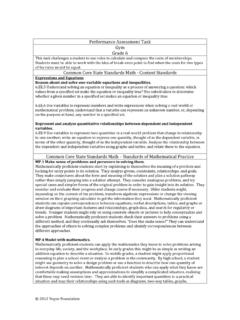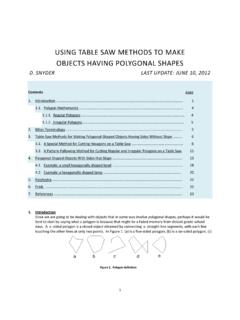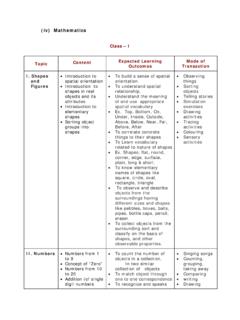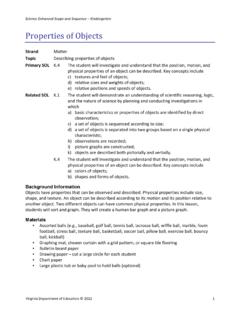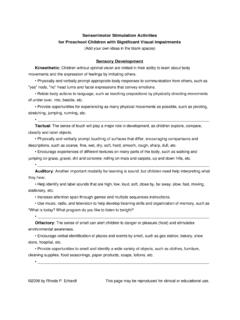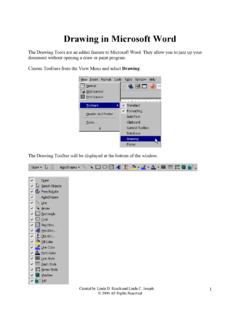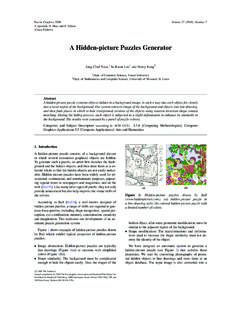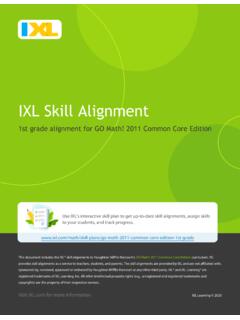Transcription of Performance Assessment Task Sorting Shapes Grade 6 task ...
1 2012 Noyce Foundation Performance Assessment Task Sorting Shapes Grade 6 task aligns in part to CCSSM Grade 5 This task challenges a student s knowledge of 2-dimensional geometrical Shapes to sort Shapes and to design a shape that has a given set of attributes. A student must be able to look at number of sides or angles, lines of symmetry, and parallel sides to sort Shapes . A student must understand the logic of Sorting to see where Shapes with multiple attributes will fall within a Venn diagram. Common Core State Standards Math - Content Standards Geometry Classify two-dimensional figures into categories based on their properties. Understand that attributes belonging to a category of two-dimensional figures also belong to all subcategories of that category.
2 For example, all rectangles have four right angles and squares are rectangles, so all squares have four right angles. Classify two-dimensional figures in a hierarchy based on properties. Common Core State Standards Math Standards of Mathematical Practice Make sense of problems and persevere in solving them. Mathematically proficient students start by explaining to themselves the meaning of a problem and looking for entry points to its solution. They analyze givens, constraints, relationships, and goals. They make conjectures about the form and meaning of the solution and plan a solution pathway rather than simply jumping into a solution attempt. They consider analogous problems, and try special cases and simpler forms of the original problem in order to gain insight into its solution.
3 They monitor and evaluate their progress and change course if necessary. Older students might, depending on the context of the problem, transform algebraic expressions or change the viewing window on their graphing calculator to get the information they need. Mathematically proficient students can explain correspondences between equations, verbal descriptions, tables, and graphs or draw diagrams of important features and relationships, graph data, and search for regularity or trends. Younger students might rely on using concrete objects or pictures to help conceptualize and solve a problem. Mathematically proficient students check their answers to problems using a different method, and they continually ask themselves, Does this make sense?
4 They can understand the approaches of others to solving complex problems and identify correspondences between different approaches. Look for and make use of structure. Mathematically proficient students try to look closely to discern a pattern or structure. Young students, for example, might notice that three and seven more is the same amount as seven and three more, or they may sort a collection of Shapes according to how many sides the Shapes have. Later, students will see 7 x 8 equals the well-remembered 7 x 5 + 7 x 3, in preparation for learning about the distributive property. In the expression x2 + 9x + 14, older students can see the 14 as 2 x 7 and the 9 as 2 + 7. They recognize the significance of an existing line in a geometric figure and can use the strategy of drawing an auxiliary line for solving problems.
5 They also can step back for an overview and shift perspective. They can see complicated things, such as some algebraic expressions, as single objects or being composed of several objects. For example, they can see 5 3(x - y)2 as 5 minus a positive number times a square and use that to realize that its value cannot be more than 5 for any real numbers x and y. Assessment Results This task was developed by the Mathematics Assessment Resource Service and administered as part of a national, normed math Assessment . For comparison purposes, teachers may be interested in the results of the national Assessment , including the total points possible for the task, the number of core points, and the percent of students that scored at standard on the task.
6 Related materials, including the scoring rubric, student work, and discussions of student understandings and misconceptions on the task, are included in the task packet. Grade Level Year Total Points Core Points % At Standard Grade 6 2006 7 4 49% AFBDEGHCS orting ShapesThis problem gives you the chance to: recognize and name Shapes and their properties draw a shape to meet given conditionsHere are some two dimensional Shapes drawn on square grid What is the mathematical name of shape F? _____2. How many lines of symmetry does shape D have? _____3. Write the letter of each shape in the correct region of the diagram on the next first one has been done for you.(c) 2006 by Mathematics Assessment Resource Service.
7 All rights Draw another shape that could go into the shaded 2006 by Mathematics Assessment6tseTsepahSgnitroS6egaPResourc e Service. All rights other shapesAShapes with at leastone line of symmetrywith no parallel sidesShapes with at leastone line of symmetrywith parallel sidesShapes with parallelsides with no linesof symmetry7(c) 2006 by Mathematics Assessment Resource Service. All rights ShapesRubricThe core elements of Performance required by this task are: recognize and name Shapes and their properties draw a shape to meet given conditionsBased on these, credit for specific aspects of Performance should be assigned as followspointssectionpoints1. Gives correct answer:hexagon112.
8 Gives correct answer:8113. Completes the letters correct with no extrasPartial credit6 or 5 letters correct4 or 3 letters correct3(2)(1)34. 1 point for a shape with line(s) of symmetry,and 1 point for a shape with no parallel Points7 BGCEADF HSixth Grade 2006Pg.(c) Noyce Foundation 2006. To reproduce this document, permission must be granted by the Noyce Grade Task 3: Sorting ShapesWork the task. Look at the rubric. What geometric attributes does a student need tounderstand to work this task?What types of work have your students done with attributes?Look at student work on part one. How many of your students put:Hexagon Trapezoid Parallelogram 3-DshapeDiamondPentagonOctagon QuadrilateralBesides memorization, how do we givestudents meaningful ways to talk aboutmathematics that would allow them to use geometric terms in context?
9 How do we help students develop the academic language of mathematics?Look at student work on part two, lines of symmetry. How many of your studentsput:8462 OtherDo we give students enough opportunities to think about symmetry that is not on thevertical or horizontal axis?Do students get opportunities to work with rotations? How might thinking aboutrotational symmetry help the studentfind additional lines of symmetry?Students need to understand the logic of Sorting and be able to think about more thanone attribute at a time to complete the diagram in part three. Many students haddifficulty thinking about a negative attribute like no parallel many of your students misplaced:BCDEFGHW hich Shapes or categories seemed most difficult for them?
10 Have your students done classifying or Sorting activities with either number orgeometric attributes?Have they had the opportunity to make their own categories to help them see the logicof the sort?Sixth Grade 2006Pg.(c) Noyce Foundation 2006. To reproduce this document, permission must be granted by the Noyce able to design a shape with given attributes is quite challenging and involvessynthesizing previous knowledge and apply it in unusual or new ways. Look atstudent work on part four. How many could design a shape matching both constraints?oWas their shape a triangle?oA circle?oOther? How many students drew Shapes with no lines of symmetry? How many students drew Shapes with parallel sides?
